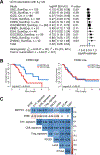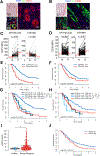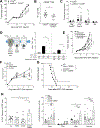CD73 Inhibits cGAS-STING and Cooperates with CD39 to Promote Pancreatic Cancer
- PMID: 36409930
- PMCID: PMC9812927
- DOI: 10.1158/2326-6066.CIR-22-0260
CD73 Inhibits cGAS-STING and Cooperates with CD39 to Promote Pancreatic Cancer
Abstract
The ectonucleotidases CD39 and CD73 catalyze extracellular ATP to immunosuppressive adenosine, and as such, represent potential cancer targets. We investigated biological impacts of CD39 and CD73 in pancreatic ductal adenocarcinoma (PDAC) by studying clinical samples and experimental mouse tumors. Stromal CD39 and tumoral CD73 expression significantly associated with worse survival in human PDAC samples and abolished the favorable prognostic impact associated with the presence of tumor-infiltrating CD8+ T cells. In mouse transplanted KPC tumors, both CD39 and CD73 on myeloid cells, as well as CD73 on tumor cells, promoted polarization of infiltrating myeloid cells towards an M2-like phenotype, which enhanced tumor growth. CD39 on tumor-specific CD8+ T cells and pancreatic stellate cells also suppressed IFNγ production by T cells. Although therapeutic inhibition of CD39 or CD73 alone significantly delayed tumor growth in vivo, targeting of both ectonucleotidases exhibited markedly superior antitumor activity. CD73 expression on human and mouse PDAC tumor cells also protected against DNA damage induced by gemcitabine and irradiation. Accordingly, large-scale pharmacogenomic analyses of human PDAC cell lines revealed significant associations between CD73 expression and gemcitabine chemoresistance. Strikingly, increased DNA damage in CD73-deficient tumor cells associated with activation of the cGAS-STING pathway. Moreover, cGAS expression in mouse KPC tumor cells was required for antitumor activity of the CD73 inhibitor AB680 in vivo. Our study, thus, illuminates molecular mechanisms whereby CD73 and CD39 seemingly cooperate to promote PDAC progression.
©2022 American Association for Cancer Research.
Figures






Similar articles
-
Ectonucleotidases CD39 and CD73 on OvCA cells are potent adenosine-generating enzymes responsible for adenosine receptor 2A-dependent suppression of T cell function and NK cell cytotoxicity.Cancer Immunol Immunother. 2011 Oct;60(10):1405-18. doi: 10.1007/s00262-011-1040-4. Epub 2011 Jun 3. Cancer Immunol Immunother. 2011. PMID: 21638125 Free PMC article.
-
Ectonucleotidase CD73 and CD39 expression in non-small cell lung cancer relates to hypoxia and immunosuppressive pathways.Life Sci. 2020 Oct 15;259:118389. doi: 10.1016/j.lfs.2020.118389. Epub 2020 Sep 6. Life Sci. 2020. PMID: 32898522
-
High-dimensional analysis of the adenosine pathway in high-grade serous ovarian cancer.J Immunother Cancer. 2021 Mar;9(3):e001965. doi: 10.1136/jitc-2020-001965. J Immunother Cancer. 2021. PMID: 33771891 Free PMC article.
-
CD73 and CD39 ectonucleotidases in T cell differentiation: Beyond immunosuppression.FEBS Lett. 2015 Nov 14;589(22):3454-60. doi: 10.1016/j.febslet.2015.07.027. Epub 2015 Jul 29. FEBS Lett. 2015. PMID: 26226423 Review.
-
The role of the CD39-CD73-adenosine pathway in liver disease.J Cell Physiol. 2021 Feb;236(2):851-862. doi: 10.1002/jcp.29932. Epub 2020 Jul 10. J Cell Physiol. 2021. PMID: 32648591 Review.
Cited by
-
Oxamate enhances the efficacy of CAR-T therapy against glioblastoma via suppressing ectonucleotidases and CCR8 lactylation.J Exp Clin Cancer Res. 2023 Sep 29;42(1):253. doi: 10.1186/s13046-023-02815-w. J Exp Clin Cancer Res. 2023. PMID: 37770937 Free PMC article.
-
Comprehensive pan-cancer analysis of CD73: Explore its association with prognosis and tumor immune microenvironment.Heliyon. 2024 Nov 12;10(22):e40329. doi: 10.1016/j.heliyon.2024.e40329. eCollection 2024 Nov 30. Heliyon. 2024. PMID: 39624281 Free PMC article.
-
Pentose phosphate pathway inhibition metabolically reprograms CD8+ T cells and disrupts CNS autoimmunity.JCI Insight. 2025 Jun 10;10(14):e184240. doi: 10.1172/jci.insight.184240. eCollection 2025 Jul 22. JCI Insight. 2025. PMID: 40493395 Free PMC article.
-
The interplay between the DNA damage response and ectonucleotidases modulates tumor response to therapy.Sci Immunol. 2023 Jul 14;8(85):eabq3015. doi: 10.1126/sciimmunol.abq3015. Epub 2023 Jul 7. Sci Immunol. 2023. PMID: 37418547 Free PMC article. Review.
-
A Phase Ib/II Randomized Clinical Trial of Oleclumab with or without Durvalumab plus Chemotherapy in Patients with Metastatic Pancreatic Ductal Adenocarcinoma.Clin Cancer Res. 2024 Oct 15;30(20):4609-4617. doi: 10.1158/1078-0432.CCR-24-0499. Clin Cancer Res. 2024. PMID: 39106081 Free PMC article. Clinical Trial.
References
-
- Neoptolemos JP, Kleeff J, Michl P, Costello E, Greenhalf W, Palmer DH. Therapeutic developments in pancreatic cancer: Current and future perspectives. Nat Rev Gastroenterol Hepatol. 2018;15:333–348. - PubMed
-
- Conroy T, Desseigne F, Ychou M, Bouché O, Guimbaud R, Bécouarn Y, et al. FOLFIRINOX versus gemcitabine for metastatic pancreatic cancer. N Engl J Med. 2011;364:1817–25. - PubMed
Publication types
MeSH terms
Substances
Grants and funding
LinkOut - more resources
Full Text Sources
Medical
Research Materials

